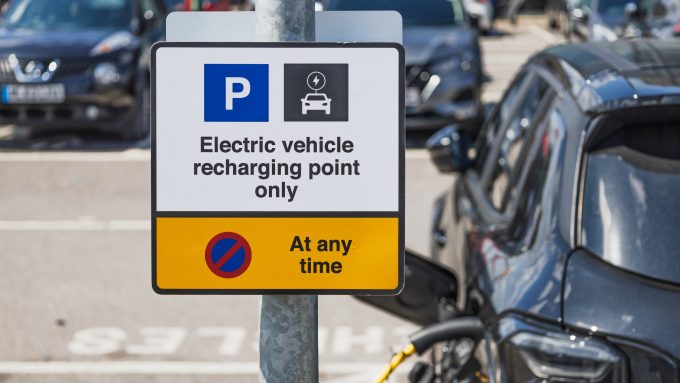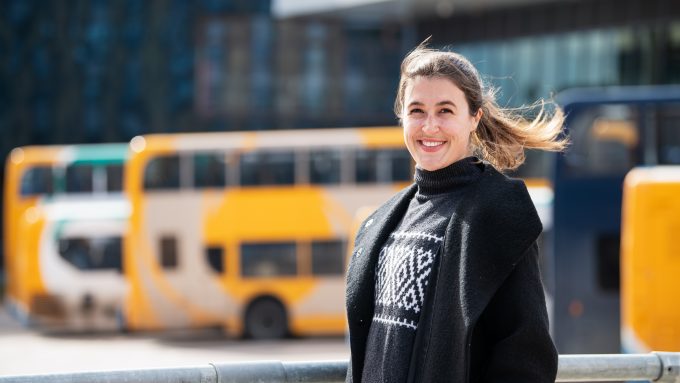
New navigation aid takes a big step towards commercial success

Rob Quinn had already come a long way in just four years when his inspiring story about living in an abandoned building in Brixton – then working from his parent’s garage in Bromley – to develop technology to help visually impaired people get around was told by Connected Places Catapult last spring. His was the first of 15 (and counting) personal profiles of leading lights in the technology world from our ‘Meet the Innovator’ series.
But now the entrepreneur – who has since relocated to a large workspace in Bermondsey, south London, and recruited a team of five – has received a major piece of news that has every chance of bringing his ambition to life in an even shorter timeframe. A consortium of investors led by EKA Ventures has agreed to plough £2.5 million into his business MakeSense Technology, and help release a product to market within 18 months.
“This investment is incredibly welcome, and will mean that we can push on and develop a viable product that can be used independently by blind and partially sighted people to navigate environments,”says Rob, who is also an honorary visiting researcher at Imperial College London. “By this time next year, I expect the company will have grown to as many as 20 people.”
Continually refining the product
As of now, Rob and his colleagues – including an industrial designer formerly with Dyson – have developed over 35 iterations of their navigation tool in various sizes to suit different hands; with the aim of making the latest version more ergonomic and user friendly than the last. “Fast forward 10 years, and blind people will be walking around with advanced assistive technology with similar capabilites to a sighted human guide,” adds Rob.
The device uses computer vision, Lidar, GPS and artificial intelligence to provide turn by turn directions to blind and partially sighted people. It works by transferring visual information gained from a camera – which points at the path in front – into subtle movements felt by the hand-held device, designed to ‘nudge’ users one way or another to indicate which way to walk and to avoid obstacles ahead.
The technology is based on an area of science known as sensory substitution (taking one sense such as sight and turning into another, such as touch), and uses underlying technology known as ‘simultaneous localisation and mapping’.
Navigation is accurate to several centimetres, although blind users are encouraged to keep hold of their cane while using the device to provide reassurance. An accompanying app has been developed to allow a blind person’s carer – or those providing ‘tele-assistance’ support – to watch a journey online in real time, and give the user prompts as to the best path to take.
For the moment, routes have to be pre-walked by a sighted pedestrian holding the device using a system known as ‘place and trace’ – designed to mimic how guide dogs can follow predefined routes. But in future it is hoped that users will be able to use the device independently to guide them to any destination.
So far the technology seems to be working: late last year MakeSense required some more money, so invited a potential investor to its office, blindfolded him and asked him to walk half a mile to Bermondsey Underground station. After the mission was completed safely and successfully, a further round of investment was promised.
MakeSense Technology received two awards of £30,000 from the Transport Research and Innovation Grants programme – delivered by Connected Places Catapult on behalf of the Department for Transport – in 2022 and the following year to help develop the concept and a functioning prototype. “If we hadn’t secured those grants, I’m not sure the company would exist today to be honest,” says Rob.

Attracting interest from America
More recently, the company has benefitted from the support of several respected champions of accessible navigation; such as the business executive and former Paralympic skier Mike May, who advises a group known as the American Printing House for the Blind, which supplies technology to blind and partially sighted people.
“Mike flew over from California a few months ago to try out our device,” explains Rob. “We had been speaking with him about it, but it is hard to understand how it works until you feel it.”
Rob was put in touch with Mike after speaking with disabilities advocate Neil Barnfather MBE from indoor navigation app GoodMaps – a subsidiary of the American company – who was impressed with the device and told his colleague that it was worth trying out.
“Blind people often ask us how the device vibrates, but it doesn’t vibrate; or how it makes a noise, but it doesn’t make a noise either. People can struggle to conceptualise it until they try it, but when they do they certainly get it,” says Rob.
To date, Makesense has secured over £370,000 from several angel investors, but the most recent injection of capital is by far the largest. Guide Dogs UK has also lent its support to the development of the product by agreeing to a user testing programme. While a piece of technology can never replace the companionship of a guide dog, Rob explains there are never enough trained dogs to meet demand, and they don’t suit everyone.
Advice for others
Rob is excited about the company’s prospects for the next few years, but is well aware of the struggles faced by many entrepreneurs starting out in trying to develop their ambitions. “You might come up with an idea and then speak to potential customers, meaning that your original idea morphs into something else. The product we have now is quite different from what I started out developing.
“My advice to others is don’t be afraid if your idea is not brilliant to begin with; just keep pushing on with it.”
Read last spring’s Meet the Innovator profile of Rob Quinn.
Find out more about the Transport Research & Innovation Grants programme.





